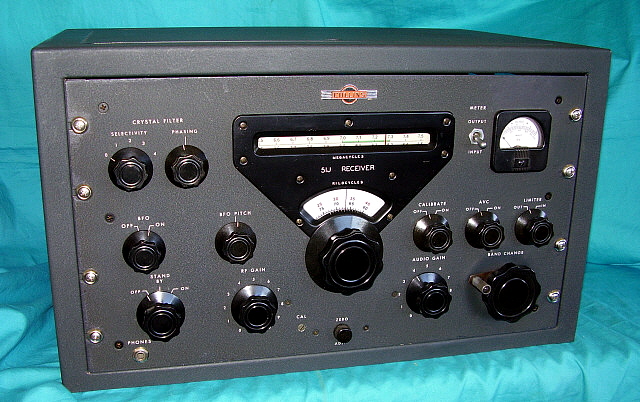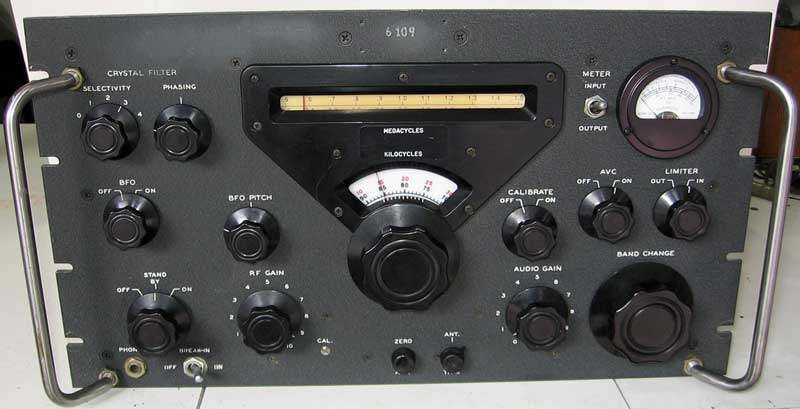
If you are a vintage radio enthusiast, then you have probably heard of the Collins 51J-2. This iconic radio receiver, produced by Collins Radio Company in the 1950s, is considered one of the best in its class. With its sleek design and advanced features, the 51J-2 quickly became a favorite among amateur radio operators and collectors alike.
The Collins 51J-2 is a single sideband (SSB) and double sideband (DSB) receiver that covers the frequency range from 540 kHz to 30 MHz. It features a high selectivity and sensitivity, making it ideal for receiving weak signals in crowded band conditions. The receiver also includes a built-in speaker, a crystal filter, and a noise blanker, which help to improve the overall performance and reduce interference.
One of the standout features of the Collins 51J-2 is its mechanical filter system. This unique system allows the user to select between different bandwidths, ranging from 6 kHz to 2.1 kHz, providing greater flexibility in receiving various types of signals. Additionally, the receiver has a notch filter that can be used to eliminate unwanted interference, such as heterodynes and adjacent channel signals.
Despite being a vintage radio receiver, the Collins 51J-2 still holds up to modern standards. Its solid construction and high-quality components ensure its durability and reliability. Many radio enthusiasts consider the 51J-2 to be a true collector’s item, as it represents a piece of radio history and showcases the craftsmanship of the time.
What is Collins 51j 2?
The Collins 51j 2 is a vintage radio receiver that was manufactured by the Collins Radio Company in the 1950s. It is considered to be one of the most iconic and sought-after radio receivers of its time. The 51j 2 was designed for amateur radio operators and enthusiasts who wanted a high-quality and reliable receiver for their radio communication needs.
The Collins 51j 2 is known for its exceptional performance and advanced features. It was built with top-of-the-line components and craftsmanship, making it a durable and long-lasting radio receiver. The 51j 2 is a tube-based receiver, which means it uses vacuum tubes to amplify and process radio signals. This technology was state-of-the-art at the time and provided superior performance compared to other receivers on the market.
One of the standout features of the Collins 51j 2 is its frequency coverage. It is capable of receiving signals across a wide range of frequencies, from longwave to shortwave. This makes it a versatile receiver that can be used for various types of radio communication, including AM, FM, and CW (continuous wave) signals. The 51j 2 also has a built-in antenna tuner, which allows users to fine-tune the receiver for optimal signal reception.
In addition to its exceptional performance, the Collins 51j 2 is also known for its beautiful design. It features a classic and timeless aesthetic, with a polished metal chassis and vintage-style knobs and dials. The receiver is also compact and portable, making it easy to transport and set up in different locations.
Overall, the Collins 51j 2 is a highly regarded vintage radio receiver that offers exceptional performance, advanced features, and a classic design. Whether you are a collector, a radio enthusiast, or an amateur radio operator, the 51j 2 is a must-have piece of equipment that will enhance your radio communication experience.
Features of Collins 51j 2
The Collins 51j 2 is a vintage radio receiver that is highly regarded for its exceptional features. Here are some of the key features that make this radio receiver stand out:
1. Frequency Coverage:
The Collins 51j 2 offers a wide frequency coverage, allowing you to tune in to a variety of radio stations. It covers the frequency range from 540 kHz to 30 MHz, ensuring that you can listen to AM and shortwave radio stations with ease.
2. Selectivity:
This radio receiver is known for its excellent selectivity, which allows you to separate different radio signals and listen to the desired station without interference. The Collins 51j 2 offers multiple selectivity options, including narrow and wide filters, ensuring that you can customize the receiver’s performance according to your preferences.
3. Sensitivity:
The Collins 51j 2 is highly sensitive, meaning that it can pick up weak radio signals and deliver clear and crisp audio. This makes it ideal for listening to distant and low-power radio stations, ensuring that you can enjoy a wide range of content from around the world.
4. Stability:
This vintage radio receiver is known for its exceptional stability, which is crucial for accurate tuning and reliable performance. The Collins 51j 2 utilizes high-quality components and advanced circuitry to ensure stable operation, allowing you to enjoy a consistent listening experience.
5. Durability:
The Collins 51j 2 is built to last, featuring a rugged construction and high-quality materials. This ensures that the radio receiver can withstand the test of time and continue to deliver excellent performance for years to come.
6. User-Friendly Controls:
Operating the Collins 51j 2 is a breeze, thanks to its user-friendly controls. The receiver features intuitive knobs and switches that allow you to easily adjust the frequency, selectivity, volume, and other settings. Whether you are a seasoned radio enthusiast or a beginner, you will find the controls of the Collins 51j 2 easy to use.
7. Vintage Design:
In addition to its exceptional performance, the Collins 51j 2 also boasts a vintage design that adds a touch of nostalgia to any radio collection. Its classic appearance, complete with retro dials and a sturdy chassis, makes it a visually appealing piece of equipment.
Overall, the Collins 51j 2 is a remarkable vintage radio receiver that offers exceptional features and performance. Whether you are a radio enthusiast or simply appreciate the charm of vintage electronics, the Collins 51j 2 is sure to impress.
How to Use Collins 51j 2

Using the Collins 51j 2 vintage radio receiver is a straightforward process that requires some basic knowledge of its controls and functions. Here is a step-by-step guide on how to use the Collins 51j 2:
1. Power On
Start by plugging in the Collins 51j 2 and turning on the power switch. Wait for the tubes to warm up before proceeding.
2. Tuning
Use the tuning knob to select the desired frequency. The Collins 51j 2 has a wide frequency range, allowing you to tune into various radio stations.
3. Band Selection

Choose the appropriate band for the frequency you want to listen to. The Collins 51j 2 offers multiple bands, including AM, FM, and shortwave.
4. Fine-Tuning

Use the fine-tuning knob to adjust the signal and achieve optimal reception. This will help eliminate any interference or static noise.
5. Volume Control
Adjust the volume control knob to your preferred listening level. Start with a lower volume and gradually increase it to avoid sudden loud noises.
6. Mode Selection
Select the desired mode, such as AM or FM, depending on the type of signal you want to receive. The Collins 51j 2 offers different modes for different types of broadcasts.
7. Antenna Adjustment
Ensure that the antenna is properly connected and positioned for optimal reception. Adjust the antenna length or direction if needed.
8. Fine-Tuning Filters
Use the fine-tuning filters to further refine the signal and reduce any unwanted noise or interference. Experiment with different filter settings to find the best reception.
9. Record or Monitor
If desired, you can use the Collins 51j 2 to record or monitor radio broadcasts. Connect a recording device or headphones to the appropriate output jacks.
By following these steps, you can effectively use the Collins 51j 2 vintage radio receiver and enjoy high-quality audio from various radio stations.
Where to Find Collins 51j 2

If you are looking to find a Collins 51j 2 radio receiver, there are a few places you can check. One option is to search online auction websites, such as eBay, where you may be able to find both new and used models. Another option is to visit online forums and communities dedicated to vintage radio equipment, as members may have a Collins 51j 2 for sale or be able to point you in the right direction.
You can also try reaching out to local ham radio clubs or enthusiasts in your area. They may have connections or know of individuals who are selling or willing to part with a Collins 51j 2. Additionally, attending ham radio swap meets or flea markets can be a great way to find vintage radio equipment, including the Collins 51j 2.
Overall, with some patience and persistence, you should be able to find a Collins 51j 2 radio receiver to add to your collection or use for your vintage radio hobby.

Over the years, I have amassed a wealth of experience and knowledge, which I eagerly share with fellow radio aficionados. Through my writing and active participation in the amateur radio community, I strive to inspire others and provide valuable insights into this fascinating hobby. Engaging in various radio activities, I continue to learn and grow, constantly amazed by the endless possibilities that radio communication offers.

